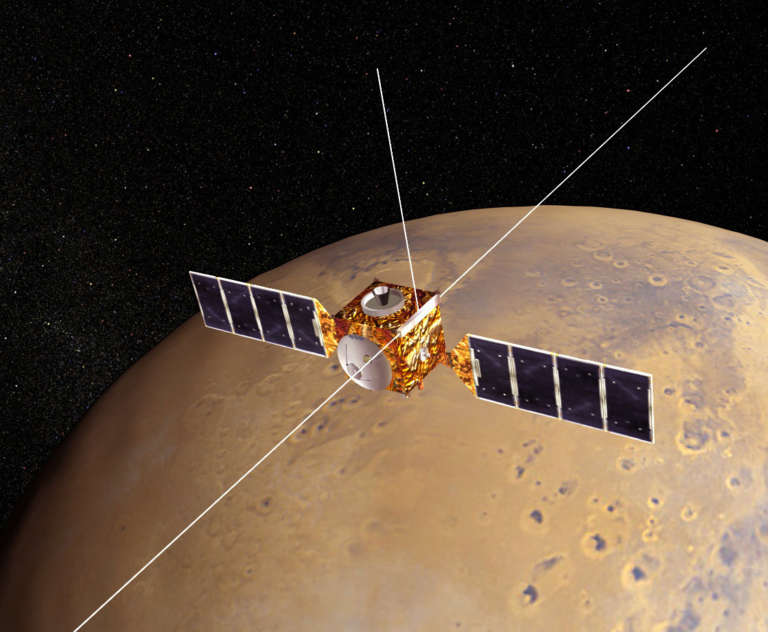Mars Express, studying Mars from orbit
Highlights
- Mars Express launched in 2003 as the European Space Agency’s first planetary mission
- The spacecraft has spotted water ice in Mars’ polar caps and possibly liquid water buried beneath them.
- Mars Express is still functioning now, making it one of the oldest working spacecraft beyond Earth.
What is Mars Express?
Launched in 2003, the Mars Express orbiter is the European Space Agency’s first mission to another planet and one of the oldest functioning spacecraft beyond Earth orbit. The original mission included both the orbiter and a lander called Beagle 2, but the lander did not work properly once it reached the surface of Mars. The orbiter, on the other hand, has been a resounding success: its original mission was intended to only last a single Martian year (687 Earth days) and has been repeatedly extended.
Those extensions were partly due to the flexible nature of the scientific instruments aboard Mars Express, which can investigate just about any scientific Mars question. The orbiter carries a set of seven instruments designed to answer some of the most fundamental questions about our planetary neighbor: what its surface, subsurface, and atmosphere are made of. In particular, the original goal of the mission — which it has fulfilled several times over — was to search for hints of underground water. It was also designed to create detailed maps of the planet, which it continuously improves and updates.
How Mars Express works
The main body of the orbiter is roughly cube-shaped, less than 2 meters (6 feet) across. The power for its scientific instruments comes from solar panels that stretch about 6 meters (20 feet) from each side of the cube, and a set of eight small thrusters provide the propulsion it needs to occasionally adjust its orbit.
Two 20-meter-long (65 feet) antennae protrude from Mars Express perpendicular to the solar panels, as well as a third, shorter boom that sticks out from another side. These antennae are part of an instrument called MARSIS, which uses radar to examine the subsurface of Mars, measure the density of the materials there, and hunt for subsurface water. The orbiter also has specialized instruments to measure the composition of the surface and the atmosphere. It also carries tools to measure the other characteristics of the atmosphere, such as how it interacts with the solar wind.
Beyond its science instruments, Mars Express also helps out missions on the surface by acting as a communications relay between landers and operators on Earth. It was originally designed to communicate with the Beagle 2 lander, but after the lander’s failure, it has been used to relay data from nearly every other spacecraft that has successfully landed on Mars, making it one of the most important tools for solar system exploration.
Major discoveries so far
In January 2004, five days before the spacecraft even reached its final science orbit on Mars, the European Space Agency announced that it had found water ice in the planet’s south polar ice cap, which was previously thought to be made of frozen carbon dioxide. Further observations later confirmed that the polar ice caps are made up of about 15% water ice, with the rest being carbon dioxide. This water could eventually be mined by interplanetary explorers, who could use it to make rocket fuel or help them stay alive on the surface.
Two months later in March, the orbiter detected traces of methane in the Martian atmosphere. The detection was fiercely debated, but in 2019 both the Curiosity rover and Mars Express detected another burst of methane. On the other hand, The ExoMars Trace Gas Orbiter, which is designed to look for compounds like methane, hasn’t spotted any, so the discovery is still tentative — but less so than before. This is important because we don’t know where the methane came from — it could have come from a geological process like gas seeping up from under the surface, but on Earth it is also produced by some microbes, so this discovery could potentially be a sign of life on Mars.
More recently, Mars Express has found hints of several lakes buried underneath the south polar ice cap, providing the first possible evidence that there may be stable bodies of liquid water on Mars. The discovery is still being debated, and these lakes may be saltier or slushier than most lakes on Earth. Nevertheless, liquid water is crucial for life as we know it, making the findings intriguing.
Mars Express has also flown close to Phobos, the larger of the planet’s two moons, passing as close as 43 kilometers (27 miles) above the moon’s surface in an effort to study its interior and take high-resolution images.
While these are the flashiest and most famous of the mission’s discoveries, Mars Express has made countless more incremental contributions to our understanding of Mars, including information on the planet’s makeup and structure as well as topographical maps that are indispensable for continuing exploration.
Support missions like Mars Express
Whether it's advocating, teaching, inspiring, or learning, you can do something for space, right now. Let's get to work.


 Explore Worlds
Explore Worlds Find Life
Find Life Defend Earth
Defend Earth



